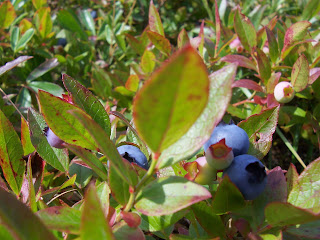 I went to Maine a few weeks ago, reading the first novel by Elizabeth Gilbert, Stern Men (thanks to Shelley) and I'm finishing it now. While I was in Maine, reading a lovely, hilarious novel about two lobstering islands (roughly based on Vinalhaven & surrounds), I was thinking about two things: lobster and my favorite professor from college, David Gross. Gross was the Mainer who introduced me to Sarah Orne Jewett and Carolyn Chute. Ends up, thanks to him, I've spent much more time reading about Maine than actually visiting it (and thanks to Chute's enormous tome, The Beans of Egypt, Maine). I hope to remedy this now that I'm a little closer.
I went to Maine a few weeks ago, reading the first novel by Elizabeth Gilbert, Stern Men (thanks to Shelley) and I'm finishing it now. While I was in Maine, reading a lovely, hilarious novel about two lobstering islands (roughly based on Vinalhaven & surrounds), I was thinking about two things: lobster and my favorite professor from college, David Gross. Gross was the Mainer who introduced me to Sarah Orne Jewett and Carolyn Chute. Ends up, thanks to him, I've spent much more time reading about Maine than actually visiting it (and thanks to Chute's enormous tome, The Beans of Egypt, Maine). I hope to remedy this now that I'm a little closer.Despite the Gilbert book, and plans to stop in Salem (for a later post), I had not planned on a terribly literary vacation. Even devoted literary tourist has to get a vacation from herself (and the subject of her dissertation). We camped at Camden Hills State Park--an amazing campground and the just kind of place, with its trails and ocean views, that didn't inspire me to read much on our trip. The world was too crisp, cool and full of sail boats to let me sit around and read much.

On our trip we took the Mt. Battie Auto Road, a popular destination within the state park. Atop Mt. Battie is a medieval looking tower built as a World War I Memorial and from which you can see all of Camden's harbor (see above) and a good & beautiful bit of Penobscot Bay. But if you turn around and look inland, you see lovely green hills and farms laid out against the grain of the hillside. And if you look under your feet, you can find both Edna St. Vincent Millay and blueberries.
In 1910, Millay wrote most of her most famous poem, "Renascence" inspired by the view at Mt. Battie (or at least that is what the marker says), which begins:
"ALL I could see from where I stood
Was three long mountains and a wood;
I turned and looked the other way,
And saw three islands in a bay."
The "three islands" in the bay include the islands that Gilbert used as models for her fictional lobstering communities, Courne Haven and Ft. Niles. And though I love the book, the central character, Ruth, is torn--or unable to articulate what it is that she loves--about her island home. And it seems that Millay (only 18 when she wrote the poem) could answer a good bit of that. In "Renascence," Millay goes on

"Over these things I could not see:
These were the things that bounded me..."
Millay's angst later in the poem is so perfectly how I felt at 18, and seems so in tune with Gilbert's Ruth, also an 18-year-old , that it's a wonder she didn't begin her chapters with epigraphs from Millay instead of quotes from the natural histories of lobsters.
Oh yes, and as we hiked around the top of Mt. Battie, we found these (above) under our feet--a real subject of my literary fascination since grade school when we read Robert McCloskey's Blueberries for Sal. Mythical wild blueberries--not just fictional after all.





